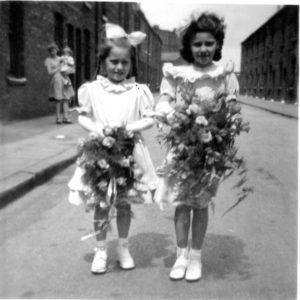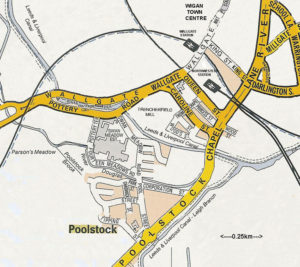The Family Connection
Poolstock, a working class neighbourhood about 1km SW of Wigan town centre, was home to many Harrison ancestors over a period of some 70 years. The Honeysuckle Inn is located in Poolstock and it was in Poolstock that Henry Harold grew up, as did his father Henry and many of their siblings.
It was mainly the Harrison branch of the family that inhabited Poolstock. Joseph Harrison and Ellen Ball moved there with their children from nearby Wood Street in the mid-1860s. They raised their family in Poolstock and remained in the neighbourhood for about 30 years until Joseph got a job in Standish in the 1890s. They occupied several Poolstock residences at different times including 6 Byrom Street, 31 Pool Street, 64 Pool Street, and 54 Poolstock Lane.
Joseph and Ellen’s children grew up in Poolstock. When they were old enough they were sent out to work locally. Joseph and Ellen’s five daughters all worked in textile mills from the age of 12 or 13, almost certainly one of the several large textile mills in or near Poolstock. Son Henry, of course, became the proprietor of the Honeysuckle Inn at 75 Pool Street.
Many of Joseph and Ellen’s children settled in Poolstock, at least for a time. Eldest son Edward lived on Corporation Street from 1885 to 1891. Henry Harrison spent most of his life in Poolstock. He married Alice Barton whose father had run the local Corporation Inn. Henry and Alice settled on Walmer Street where Henry Harold was born. After Alice died he married Elizabeth Donahue who lived at 90 Pool Street. When they left the Honeysuckle Henry and Elizabeth lived on Tipping Street and they were living at 88 Poolstock when Henry died. Elizabeth was living on Chadwick Street when she passed away in 1961.
A Brief History of Poolstock
An ordinance survey map circa 1849 shows present day Poolstock as a stretch of farmland to the north of Poolstock Lane. The residential development of Poolstock apparently took place circa 1850. At the time of the 1851 census the description of the enumeration district that included Poolstock was described, in part, as “the whole of the northerly side of Poolstock, the whole of the new buildings lately raised by the Messrs James and Nathaniel Eckersley consisting of Byrom Street, Pool Street, Baker Street, Institution Street and ending with the Swift’s Buildings adjoining the old River Douglas.” Nathaniel Eckersley was, at the time, the Mayor of Wigan and a coal mining magnate.
By this time the Swan Meadows and Trencherfield textile mills were established in the northern part of Poolstock, along with the smaller Bridge Hey cotton mill to the east. Both the Swan Meadows and Trencherfield Mills were redeveloped many times over the years to expand production and introduce improved technologies.
Compared with the 1849 map of Poolstock, the 1894 ordinance survey map illustrates the extensive industrial development that transpired in Poolstock and beyond during the second half of the 19th century. The Swan Meadows and Trencherfield Mills had been greatly expanded. The Western, Poolstock and Worsley Mesnes Mills had been constructed. St. James Church had been erected in 1863 at the south end of Poolstock. Extensive new industry and infrastructure is apparent everywhere.
Much of the Poolstock residential neighbourhood was completely redeveloped sometime in the mid-20th century. Apart from the major arteries of Pool Street, Poolstock Lane and Corporation Street, the neighbourhood streets on which members of the Harrison clan resided can, for the most part, no longer be found (although a few residential streets have retained the old names).
 There is not much record of what Poolstock looked like before it was redeveloped. However this photograph of two young girls, taken on Walking Day, shows Byrom Street with the Swan Meadow Mill looming in the background. It was probably taken in the 1940s or 50s. Together with the old ordinance survey maps and census records we can conclude that Poolstock comprised long rows of identical two-story brick houses, each with about twelve feet of frontage directly on the street, a door, and a couple of windows. The houses were about twenty-four feet deep with a back garden extending about twelve feet behind each house. The garden was, no doubt, the location of the sanitary facilities. The houses probably had no running water, at least during the 19th century. Doris Darbyshire tells us more about Poolstock residences in her verse The River Douglas:
There is not much record of what Poolstock looked like before it was redeveloped. However this photograph of two young girls, taken on Walking Day, shows Byrom Street with the Swan Meadow Mill looming in the background. It was probably taken in the 1940s or 50s. Together with the old ordinance survey maps and census records we can conclude that Poolstock comprised long rows of identical two-story brick houses, each with about twelve feet of frontage directly on the street, a door, and a couple of windows. The houses were about twenty-four feet deep with a back garden extending about twelve feet behind each house. The garden was, no doubt, the location of the sanitary facilities. The houses probably had no running water, at least during the 19th century. Doris Darbyshire tells us more about Poolstock residences in her verse The River Douglas:
T’ houses were built fert workers, ut mill in owd Nat’s pit,
They huddled wun another, un were moost inadiqwit.Sum workers cud’nt affoord much rent, no moor thun haaf u creawn,
They felt themselves reet lucky, wi two rooms up, two deawn.Un sum ad only wun below, un wun abuv fer’t bed,
Ther weren’t much room fert move abeawt, tho it wos o roof ower t’hed.But them i’ Corporation Street, ad o parler un o lobby,
Ther backyards stretched tut river bank, un thy grew fleawers fer o hobby.To live theer cost moor money, they hed av o job o skill,
O fireman ut pit maybe, or o owerlooker ut mill.
Poolstock Today
 Poolstock is a short walk from the Wigan train stations in the centre of town. Walk west along Wallgate and Pottery Road for about 500 metres (passing the Wigan Pier Heritage Centre) and turn south down Swan Meadows Road into Poolstock. On Swan Meadows Road you will pass the empty hulks of two gigantic 19th century textile mills on either side: the Trencherfield Mill and the Swan Meadows Mill. Each mill consists of a main building and a number of outbuildings, all built of brick. The main buildings cover the area of a football field and are five or six stories high. These mills, or places like them, were the workplaces of many Harrisons in the late 19th and early 20th centuries, including Henry Harrison, all of his sisters, and many of his cousins. Mill workers were almost certainly the main customers for the Honeysuckle Inn at the beginning and end of each work day. The mill buildings have been abandoned for many decades but are now gradually being converted for other uses. The Trencherfield Mill contains a museum that is a working, turn-of-the-century, spinning mill.
Poolstock is a short walk from the Wigan train stations in the centre of town. Walk west along Wallgate and Pottery Road for about 500 metres (passing the Wigan Pier Heritage Centre) and turn south down Swan Meadows Road into Poolstock. On Swan Meadows Road you will pass the empty hulks of two gigantic 19th century textile mills on either side: the Trencherfield Mill and the Swan Meadows Mill. Each mill consists of a main building and a number of outbuildings, all built of brick. The main buildings cover the area of a football field and are five or six stories high. These mills, or places like them, were the workplaces of many Harrisons in the late 19th and early 20th centuries, including Henry Harrison, all of his sisters, and many of his cousins. Mill workers were almost certainly the main customers for the Honeysuckle Inn at the beginning and end of each work day. The mill buildings have been abandoned for many decades but are now gradually being converted for other uses. The Trencherfield Mill contains a museum that is a working, turn-of-the-century, spinning mill.
A few hundred metres south Swan Meadows Road becomes Pool Street as it crosses the River Douglas. The Douglas was an important waterway in Wigan up to the middle of the 18th century. At 75 Pool Street, on the south bank of the River Douglas, in the shadow of the Swan Meadows Mill, sits the Honeysuckle Inn. Stop in for a pint!
A few hundred metres south of the Honeysuckle is the junction with Poolstock. At the south west corner of the intersection sits St. James’ church which, after it was built in 1863, was probably the parish church for members of the Harrison family who attended services. On the south side of Poolstock is the Leeds – Liverpool Canal (Leigh Branch) and beyond the canal is a wooded area. A number of Harrison ancestors lived in houses on the south side of Poolstock between the road and the canal, including Joseph Harrison and his daughters in 1891 (No. 54 Poolstock Lane) and Henry Harrison (No. 88 Poolstock) at the time of his death in 1937. Along with the Honeysuckle Inn we believe these are the only ancestral homes in and around Poolstock that have survived until today.